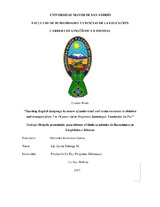Mostrar el registro sencillo del ítem
Teaching english language by means of audiovisual and realia resources to children and teenagers from 7 to 18 years old at Programa Jilañataqui, Fundacion La Paz
| dc.contributor.author | Bustencio Garcia, Mercedes | |
| dc.contributor.author | Taborga M., Javier (tutor) | |
| dc.date.accessioned | 2018-05-22T16:31:39Z | |
| dc.date.available | 2018-05-22T16:31:39Z | |
| dc.date.issued | 2013 | |
| dc.identifier.citation | Lenguas Extranjeras. Inglés. | es_ES |
| dc.identifier.uri | http://repositorio.umsa.bo/xmlui/handle/123456789/16136 | |
| dc.description.abstract | The English language has lately become a tool almost all over the world; people need to communicate to express what they feel, what they think or maybe they use this language only to do business. Therefore, learning English has become very important nowadays, fortunately, most people, children, teenagers, or adults can learn this language. Aware of the importance of English, this project is focused on the teaching of English language at elementary level to young children and teenagers at Programa Jilañataqui, Fundación La Paz. Most students who attend the institution have to face rather hard circumstances in the outside world. That is why we decided to develop our project there, in order to provide the students the opportunity to learn English as a foreign language during an eight-month-term, so that they will have similar opportunities that the students who attend regular schools have. At this stage of their lives, childhood and teens, students have much more predisposition to learn languages, fact that is corroborated by Dicks (2009) who argues that children develop conscious awareness of language getting intuitive capacities and teenagers are able to plan their new language onto concepts about the world which they already possess from their first language. Thus, our intention was to teach English at elementary, for this purpose we used audiovisual and realia resources, so that, students can associate the images with the words; these resources motivated students to learn English. Thus, we developed and applied a syllabus design which was prepared according to the students’ needs and based on the program of the institution. On the other hand, although this project makes use of different methods, it is mainly based on the communicative approach, which encourages students to build up short sentences and short conversations among them from the very beginning of their studies; they start to do it step by step according to each unit. At the same time they developed certain language abilities. These resources, audiovisual and realia, support the students’ progress while learning the English language, young children get knowledge about English and teenagers reinforce and improve their learning progress of English which will be useful for them in the future, since they occasionally will have the opportunity to interact with English speaking volunteers. This project has proved that it is possible to achieve successful results among the students without having to follow a difficult and expensive proposal. | es_ES |
| dc.language.iso | en | es_ES |
| dc.publisher | Universidad Mayor de San Andrés. Facultad de Humanidades y Ciencias de la Educación. Carrera de Lingüística e Idiomas. | es_ES |
| dc.subject | Teaching English Language - Programa Jilañataqui | es_ES |
| dc.title | Teaching english language by means of audiovisual and realia resources to children and teenagers from 7 to 18 years old at Programa Jilañataqui, Fundacion La Paz | es_ES |
| dc.type | Thesis | es_ES |

